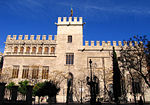Prehistory Museum of Valencia

The Prehistory Museum of Valencia is a museum of the city of Valencia (Spain) that exposes archaeological materials covering from Paleolithic to the Visigoths period. From 1982 it has been part of The Old House of Charity, built in 1841 which highlights the Byzantine style church built in 1881. The Font de Mussa Mosaic is one of the most highlighted pieces.In 1995 began the complete restoration of the building, carried out by the architect Rafael Rivera. The House of Charity, now the Museum of Prehistory, has a ground floor and two stories arranged around five courtyards. On the ground floor are located the shop, cafeteria, two temporary exhibition rooms, workshops, warehouses and the Restoration and Quaternary Wildlife laboratories, as well as offices of the Prehistoric Research Service, while the Church has become the Hall. On the first floor are the Library and the Permanent Facilities dedicated to Paleolithic Neolithic and Bronze Age. On the second floor permanent galleries devoted to the Iberian culture and the Roman World.
Excerpt from the Wikipedia article Prehistory Museum of Valencia (License: CC BY-SA 3.0, Authors, Images).Prehistory Museum of Valencia
Carrer de la Corona, Valencia Ciutat Vella
Geographical coordinates (GPS) Address Phone number Website Nearby Places Show on map
Geographical coordinates (GPS)
| Latitude | Longitude |
|---|---|
| N 39.478333333333 ° | E -0.38305555555556 ° |
Address
Centre Cultural la Beneficiència (Centre Museístic la Beneficiència)
Carrer de la Corona 36
46003 Valencia, Ciutat Vella
Valencian Community, Spain
Open on Google Maps











